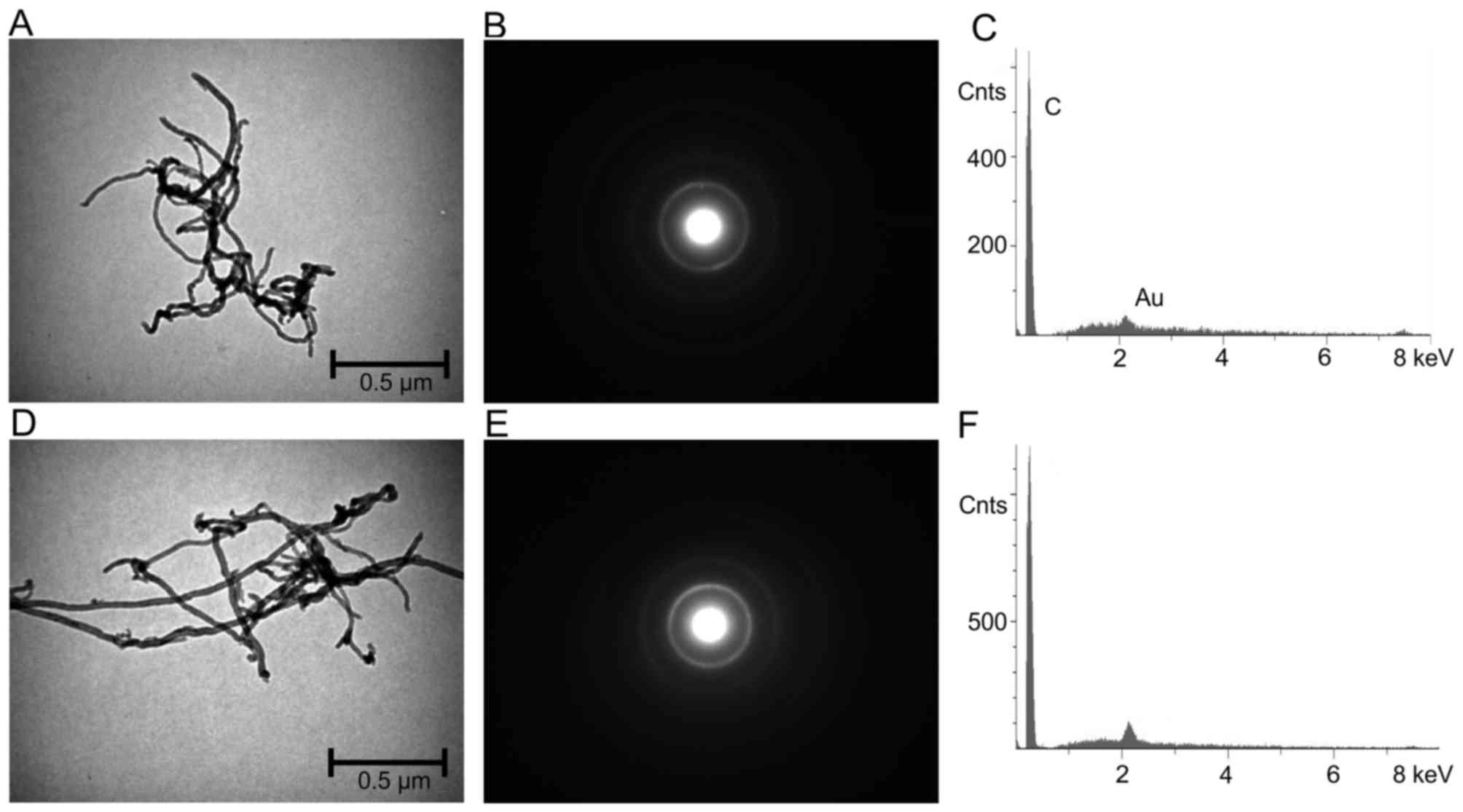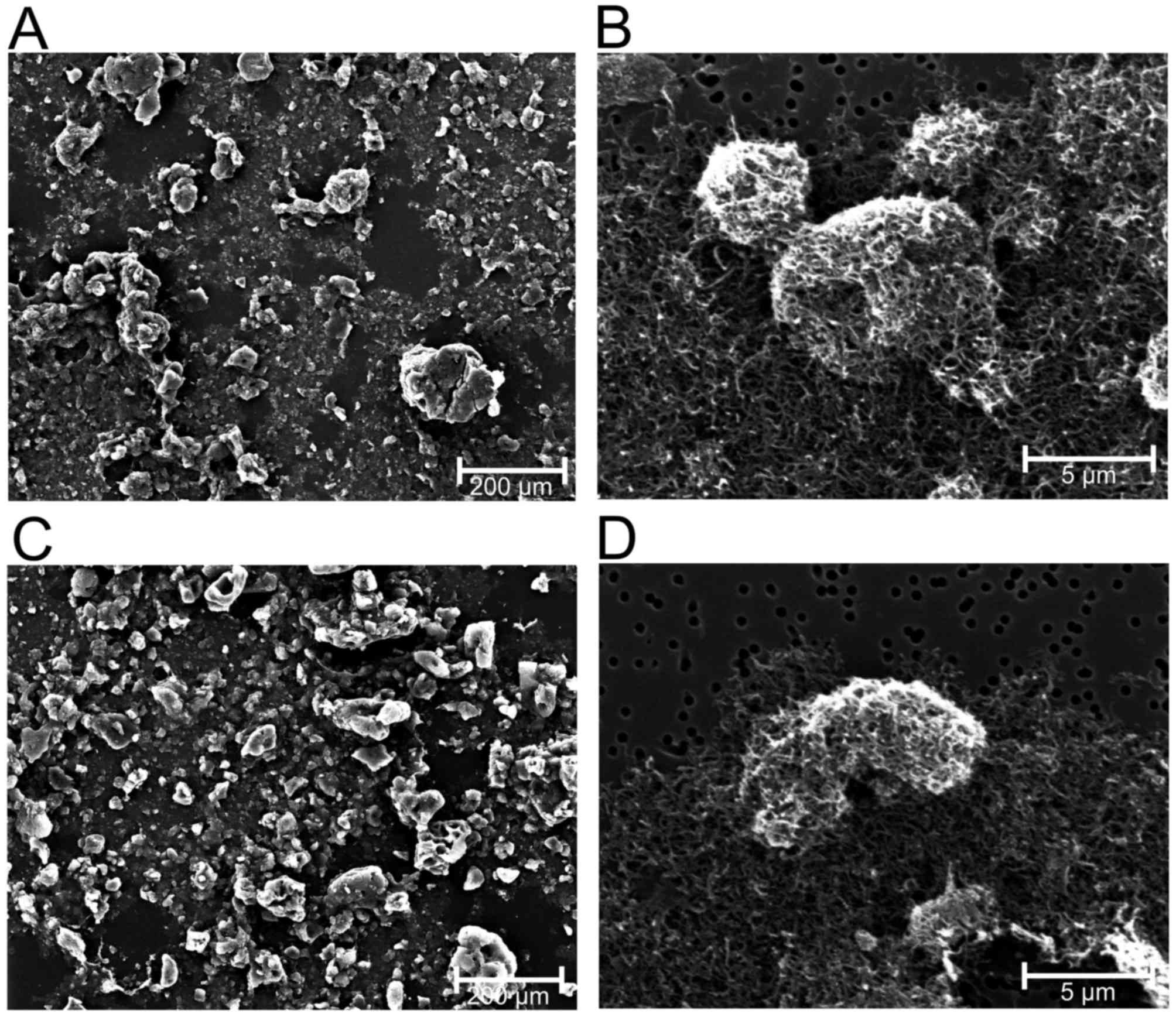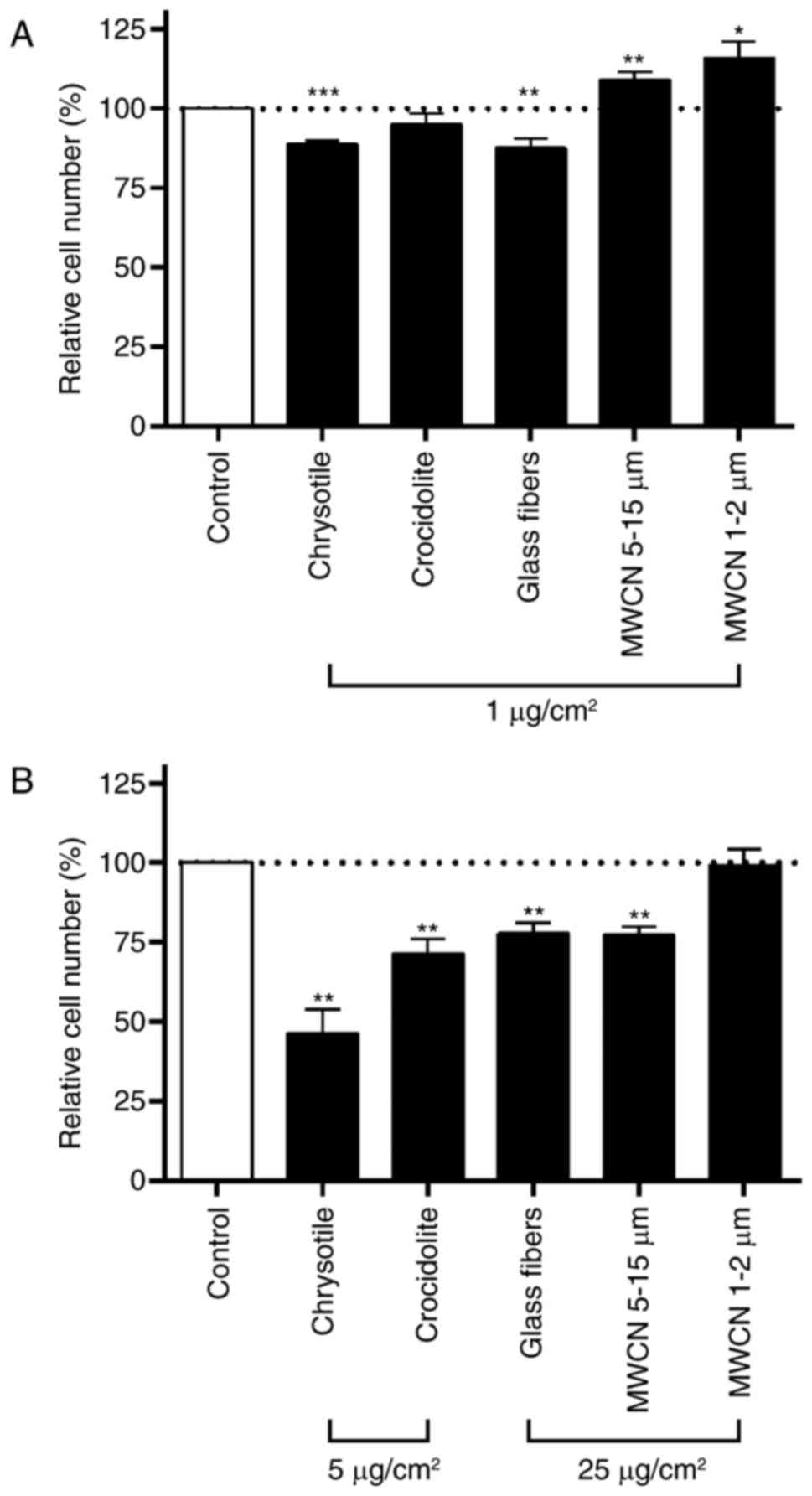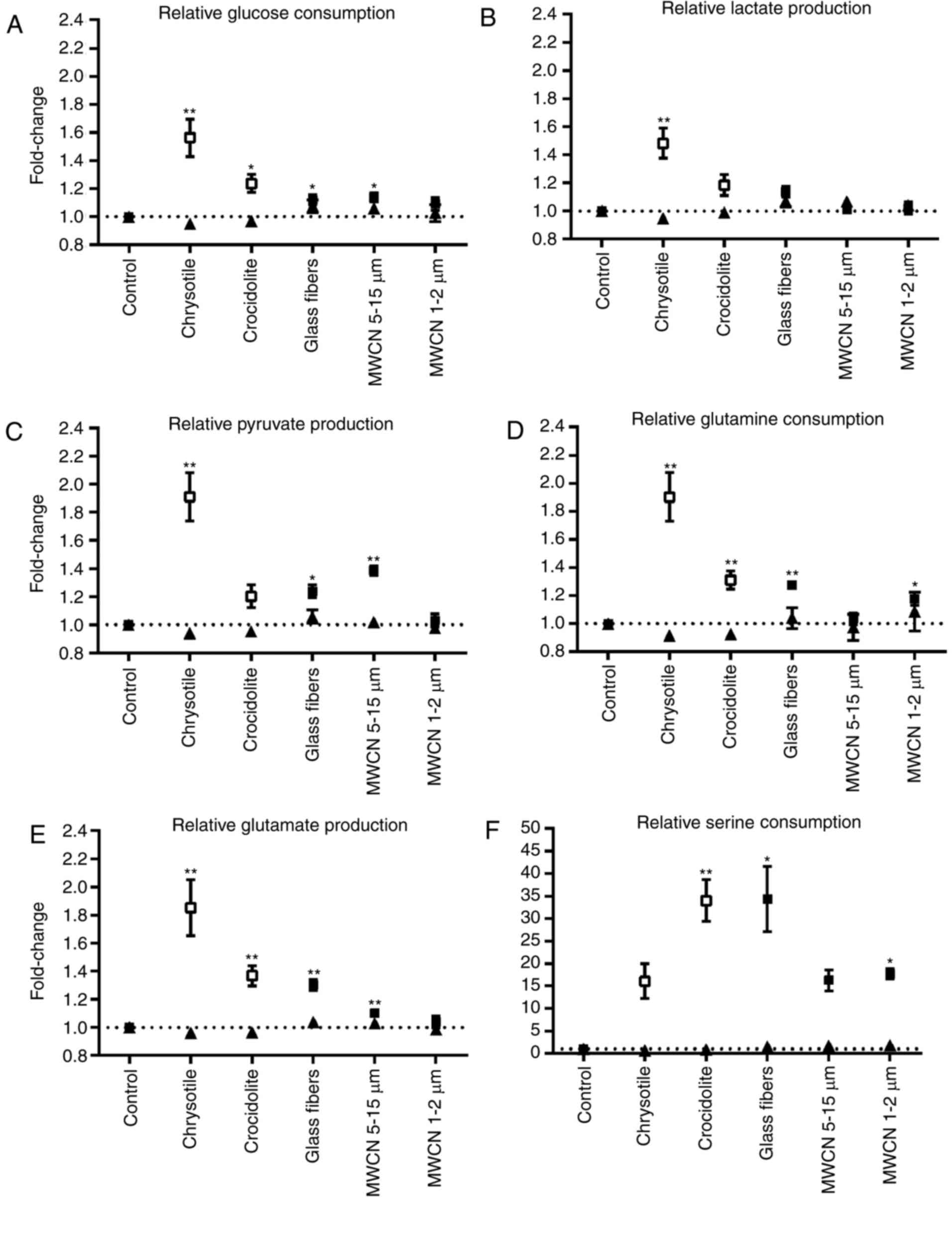|
1
|
Thermal Insulation Manufactures
Association, Nomenclature Committee, . Manmade vitreous fibers.
Nomenclature, chemistry and physical properties. The Committe;
Stanford, CT: 1991
|
|
2
|
IARC Working Group on the Evaluation of
Carcinogenic Risks to Humans, . Man-made vitreous fibres. IARC
Monogr Eval Carcinog Risks Hum. 81:1–381. 2002.PubMed/NCBI
|
|
3
|
IARC Working Group on the Evaluation of
Carcinogenic Risks to Humans, . Arsenic, metals, fibres, and dusts.
IARC Monogr Eval Carcinog Risks Hum. 100:11–465. 2012.PubMed/NCBI
|
|
4
|
World Health Organization, . Determination
of airborne fibre number concentrations. A recommended method, by
phase-contrast optical microscopy, membrane filter method. World
Health Organization; Geneva: 1997
|
|
5
|
Schinwald A, Chernova T and Donaldson K:
Use of silver nanowires to determine thresholds for fibre
length-dependent pulmonary inflammation and inhibition of
macrophage migration in vitro. Part Fibre Toxicol. 9:472012.
View Article : Google Scholar : PubMed/NCBI
|
|
6
|
Schinwald A and Donaldson K: Use of
back-scatter electron signals to visualise cell/nanowires
interactions in vitro and in vivo; frustrated phagocytosis of long
fibres in macrophages and compartmentalisation in mesothelial cells
in vivo. Part Fibre Toxicol. 9:342012. View Article : Google Scholar : PubMed/NCBI
|
|
7
|
Rittinghausen S, Hackbarth A, Creutzenberg
O, Ernst H, Heinrich U, Leonhardt A and Schaudien D: The
carcinogenic effect of various multi-walled carbon nanotubes
(MWCNTs) after intraperitoneal injection in rats. Part Fibre
Toxicol. 11:592014. View Article : Google Scholar : PubMed/NCBI
|
|
8
|
Poland CA, Duffin R, Kinloch I, Maynard A,
Wallace WA, Seaton A, Stone V, Brown S, Macnee W and Donaldson K:
Carbon nanotubes introduced into the abdominal cavity of mice show
asbestos-like pathogenicity in a pilot study. Nat Nanotechnol.
3:423–428. 2008. View Article : Google Scholar : PubMed/NCBI
|
|
9
|
van Berlo D, Wilhelmi V, Boots AW,
Hullmann M, Kuhlbusch TA, Bast A, Schins RP and Albrecht C:
Apoptotic, inflammatory, and fibrogenic effects of two different
types of multi-walled carbon nanotubes in mouse lung. Arch Toxicol.
88:1725–1737. 2014. View Article : Google Scholar : PubMed/NCBI
|
|
10
|
DFG, . Fibrous Dust [MAK Value
Documentation]. Wiley-VCH Verlag GmbH & Co; KGaA, Weinheim: pp.
142–338. 1997
|
|
11
|
Nymark P, Lindholm PM, Korpela MV, Lahti
L, Ruosaari S, Kaski S, Hollmén J, Anttila S, Kinnula VL and
Knuutila S: Gene expression profiles in asbestos-exposed epithelial
and mesothelial lung cell lines. BMC Genomics. 8:622007. View Article : Google Scholar : PubMed/NCBI
|
|
12
|
Hevel JM, Olson-Buelow LC, Ganesan B,
Stevens JR, Hardman JP and Aust AE: Novel functional view of the
crocidolite asbestos-treated A549 human lung epithelial
transcriptome reveals an intricate network of pathways with
opposing functions. BMC Genomics. 9:3762008. View Article : Google Scholar : PubMed/NCBI
|
|
13
|
Helmig S, Dopp E, Wenzel S, Walter D and
Schneider J: Induction of altered mRNA expression profiles caused
by fibrous and granular dust. Mol Med Rep. 9:217–228.
2014.PubMed/NCBI
|
|
14
|
Armand L, Biola-Clier M, Bobyk L,
Collin-Faure V, Diemer H, Strub JM, Cianferani S, Van Dorsselaer A,
Herlin-Boime N, Rabilloud T and Carriere M: Molecular responses of
alveolar epithelial A549 cells to chronic exposure to titanium
dioxide nanoparticles: A proteomic view. J Proteomics. 134:163–173.
2016. View Article : Google Scholar : PubMed/NCBI
|
|
15
|
Lieber M, Smith B, Szakal A, Nelson-Rees W
and Todaro G: A continuous tumor-cell line from a human lung
carcinoma with properties of type II alveolar epithelial cells. Int
J Cancer. 17:62–70. 1976. View Article : Google Scholar : PubMed/NCBI
|
|
16
|
Witherden IR, Bon EJ Vanden, Goldstraw P,
Ratcliffe C, Pastorino U and Tetley TD: Primary human alveolar type
II epithelial cell chemokine release: Effects of cigarette smoke
and neutrophil elastase. Am J Respir Cell Mol Biol. 30:500–509.
2004. View Article : Google Scholar : PubMed/NCBI
|
|
17
|
Foster KA, Oster CG, Mayer MM, Avery ML
and Audus KL: Characterization of the A549 cell line as a type II
pulmonary epithelial cell model for drug metabolism. Exp Cell Res.
243:359–366. 1998. View Article : Google Scholar : PubMed/NCBI
|
|
18
|
Giard DJ, Aaronson SA, Todaro GJ, Arnstein
P, Kersey JH, Dosik H and Parks WP: In vitro cultivation of human
tumors: Establishment of cell lines derived from a series of solid
tumors. J Natl Cancer Inst. 51:1417–1423. 1973. View Article : Google Scholar : PubMed/NCBI
|
|
19
|
Wottrich R, Diabaté S and Krug HF:
Biological effects of ultrafine model particles in human
macrophages and epithelial cells in mono- and co-culture. Int J Hyg
Environ Health. 207:353–361. 2004. View Article : Google Scholar : PubMed/NCBI
|
|
20
|
Castell JV, Donato MT and Gómez-Lechón MJ:
Metabolism and bioactivation of toxicants in the lung. The in vitro
cellular approach. Exp Toxicol Pathol. 57 Suppl 1:S189–S204. 2005.
View Article : Google Scholar
|
|
21
|
Nagatomo H, Morimoto Y, Ogami A, Hirohashi
M, Oyabu T, Kuroda K, Higashi T and Tanaka I: Change of heme
oxygenase-1 expression in lung injury induced by chrysotile
asbestos in vivo and in vitro. Inhal Toxicol. 19:317–323. 2007.
View Article : Google Scholar : PubMed/NCBI
|
|
22
|
Matsuoka M, Igisu H and Morimoto Y:
Phosphorylation of p53 protein in A549 human pulmonary epithelial
cells exposed to asbestos fibers. Environ Health Perspect.
111:509–512. 2003. View
Article : Google Scholar : PubMed/NCBI
|
|
23
|
Johnson NF and Jaramillo RJ: p53, Cip1,
and Gadd153 expression following treatment of A549 cells with
natural and man-made vitreous fibers. Environ Health Perspect. 105
Suppl 5:S1143–S1145. 1997. View
Article : Google Scholar
|
|
24
|
Signorelli S, Jennings P, Leonard MO and
Pfaller W: Differential effects of hypoxic stress in alveolar
epithelial cells and microvascular endothelial cells. Cell Physiol
Biochem. 25:135–144. 2010. View Article : Google Scholar : PubMed/NCBI
|
|
25
|
Jing XG, Chen TF, Huang C, Wang H, An L,
Cheng Z and Zhang GJ: MiR-15a expression analysis in non-small cell
lung cancer A549 cells under local hypoxia microenvironment. Eur
Rev Med Pharmacol Sci. 21:2069–2074. 2017.PubMed/NCBI
|
|
26
|
ATCC®.org.: ‘A549 cell line:
CCl-185 product description, documentation p53 hotspot mutation
data’. https://www.lgcstandards-atcc.org/~/media/2B3C84F951E24E668C78EB70809C7613.ashx
|
|
27
|
DeBerardinis RJ, Mancuso A, Daikhin E,
Nissim I, Yudkoff M, Wehrli S and Thompson CB: Beyond aerobic
glycolysis: Transformed cells can engage in glutamine metabolism
that exceeds the requirement for protein and nucleotide synthesis.
Proc Natl Acad Sci USA. 104:pp. 19345–19350. 2007; View Article : Google Scholar :
|
|
28
|
Eigenbrodt E, Kallinowski F, Ott M,
Mazurek S and Vaupel P: Pyruvate kinase and the interaction of
amino acid and carbohydrate metabolism in solid tumors. Anticancer
Res. 18:3267–3274. 1998.
|
|
29
|
Mazurek S, Boschek CB, Hugo F and
Eigenbrodt E: Pyruvate kinase type M2 and its role in tumor growth
and spreading. Semin Cancer Biol. 15:300–308. 2005. View Article : Google Scholar
|
|
30
|
Christofk HR, Heiden MG Vander, Harris MH,
Ramanathan A, Gerszten RE, Wei R, Fleming MD, Schreiber SL and
Cantley LC: The M2 splice isoform of pyruvate kinase is important
for cancer metabolism and tumour growth. Nature. 452:230–233. 2008.
View Article : Google Scholar
|
|
31
|
Mazurek S, Michel A and Eigenbrodt E:
Effect of extracellular AMP on cell proliferation and metabolism of
breast cancer cell lines with high and low glycolytic rates. J Biol
Chem. 272:4941–4952. 1997. View Article : Google Scholar
|
|
32
|
Unterluggauer H, Mazurek S, Lener B,
Hütter E, Eigenbrodt E, Zwerschke W and Jansen-Dürr P: Premature
senescence of human endothelial cells induced by inhibition of
glutaminase. Biogerontology. 9:247–259. 2008. View Article : Google Scholar
|
|
33
|
Li P, Liu T, Kamp DW, Lin Z, Wang Y, Li D,
Yang L, He H and Liu G: The c-Jun N-terminal kinase signaling
pathway mediates chrysotile asbestos-induced alveolar epithelial
cell apoptosis. Mol Med Rep. 11:3626–3634. 2015. View Article : Google Scholar
|
|
34
|
Leyva FJ and Roberts K: Crocidolite
induces prostaglandin I(2) release mediated by vitronectin receptor
and cyclooxygenase-2 in lung cells. Lung. 188:133–141. 2010.
View Article : Google Scholar :
|
|
35
|
Srivastava RK, Lohani M, Pant AB and
Rahman Q: Cyto-genotoxicity of amphibole asbestos fibers in
cultured human lung epithelial cell line: Role of surface iron.
Toxicol Ind Health. 26:575–582. 2010. View Article : Google Scholar : PubMed/NCBI
|
|
36
|
Nymark P, Jensen KA, Suhonen S, Kembouche
Y, Vippola M, Kleinjans J, Catalán J, Norppa H, van Delft J and
Briedé JJ: Free radical scavenging and formation by multi-walled
carbon nanotubes in cell free conditions and in human bronchial
epithelial cells. Part Fibre Toxicol. 11:42014. View Article : Google Scholar : PubMed/NCBI
|
|
37
|
Ueki A: Biological effects of asbestos
fibers on human cells in vitro-especially on lymphocytes and
neutrophils. Ind Health. 39:84–93. 2001. View Article : Google Scholar : PubMed/NCBI
|
|
38
|
Tabet L, Bussy C, Amara N, Setyan A,
Grodet A, Rossi MJ, Pairon JC, Boczkowski J and Lanone S: Adverse
effects of industrial multiwalled carbon nanotubes on human
pulmonary cells. J Toxicol Environ Health A. 72:60–73. 2009.
View Article : Google Scholar : PubMed/NCBI
|
|
39
|
Lobo C, Ruiz-Bellido MA, Aledo JC, Márquez
J, Núnez de Castro I and Alonso FJ: Inhibition of glutaminase
expression by antisense mRNA decreases growth and tumourigenicity
of tumour cells. Biochem J. 348:257–261. 2000. View Article : Google Scholar : PubMed/NCBI
|
|
40
|
Yang M and Vousden KH: Serine and
one-carbon metabolism in cancer. Nat Rev Cancer. 16:650–662. 2016.
View Article : Google Scholar : PubMed/NCBI
|
|
41
|
Mazurek S, Zwerschke W, Jansen-Dürr P and
Eigenbrodt E: Effects of the human papilloma virus HPV-16 E7
oncoprotein on glycolysis and glutaminolysis: Role of pyruvate
kinase type M2 and the glycolytic-enzyme complex. Biochem J.
356:247–256. 2001. View Article : Google Scholar : PubMed/NCBI
|
|
42
|
Wang L, Stueckle TA, Mishra A, Derk R,
Meighan T, Castranova V and Rojanasakul Y: Neoplastic-like
transformation effect of single-walled and multi-walled carbon
nanotubes compared to asbestos on human lung small airway
epithelial cells. Nanotoxicology. 8:485–507. 2014.doi:
10.3109/17435390.2013.801089. View Article : Google Scholar : PubMed/NCBI
|
|
43
|
Dang CV: Rethinking the Warburg effect
with Myc micromanaging glutamine metabolism. Cancer Res.
70:859–862. 2010. View Article : Google Scholar : PubMed/NCBI
|
|
44
|
Riganti C, Aldieri E, Bergandi L, Fenoglio
I, Costamagna C, Fubini B, Bosia A and Ghigo D: Crocidolite
asbestos inhibits pentose phosphate oxidative pathway and glucose
6-phosphate dehydrogenase activity in human lung epithelial cells.
Free Radic Biol Med. 32:938–949. 2002. View Article : Google Scholar : PubMed/NCBI
|
|
45
|
Cardinali G, Kovacs D, Maresca V, Flori E,
Del l'Anna ML, Campopiano A, Casciardi S, Spagnoli G, Torrisi MR
and Picardo M: Differential in vitro cellular response induced by
exposure to synthetic vitreous fibers (SVFs) and asbestos
crocidolite fibers. Exp Mol Pathol. 81:31–41. 2006. View Article : Google Scholar : PubMed/NCBI
|
|
46
|
Garza KM, Soto KF and Murr LE:
Cytotoxicity and reactive oxygen species generation from aggregated
carbon and carbonaceous nanoparticulate materials. Int J
Nanomedicine. 3:83–94. 2008.PubMed/NCBI
|
|
47
|
Golladay SA, Park SH and Aust AE: Efflux
of reduced glutathione after exposure of human lung epithelial
cells to crocidolite asbestos. Environ Health Perspect. 105 Suppl
5:S1273–S1277. 1997. View Article : Google Scholar
|
|
48
|
Finkel T: Signal transduction by
mitochondrial oxidants. J Biol Chem. 287:4434–4440. 2012.
View Article : Google Scholar : PubMed/NCBI
|
|
49
|
Nadeau D and Lane DA: The cytotoxicity of
chrysotile asbestos fibers to pulmonary alveolar macrophages. I.
Effects of inhibitors of ADP-ribosyl transferase. Cell Biol
Toxicol. 4:13–30. 1988. View Article : Google Scholar : PubMed/NCBI
|
|
50
|
Pink M, Verma N, Rettenmeier AW and
Schmitz-Spanke S: Integrated proteomic and metabolomic analysis to
assess the effects of pure and benzo[a]pyrene-loaded carbon black
particles on energy metabolism and motility in the human
endothelial cell line EA.hy926. Arch Toxicol. 88:913–934. 2014.
View Article : Google Scholar : PubMed/NCBI
|














